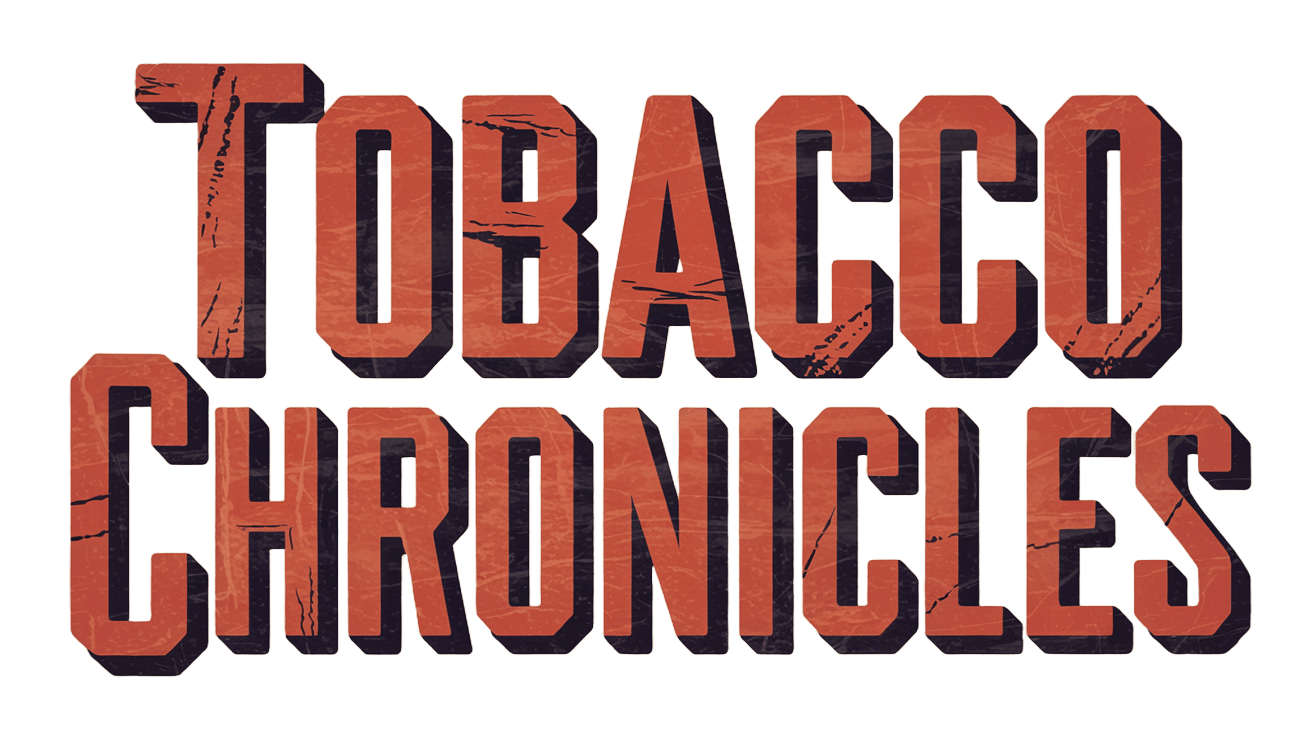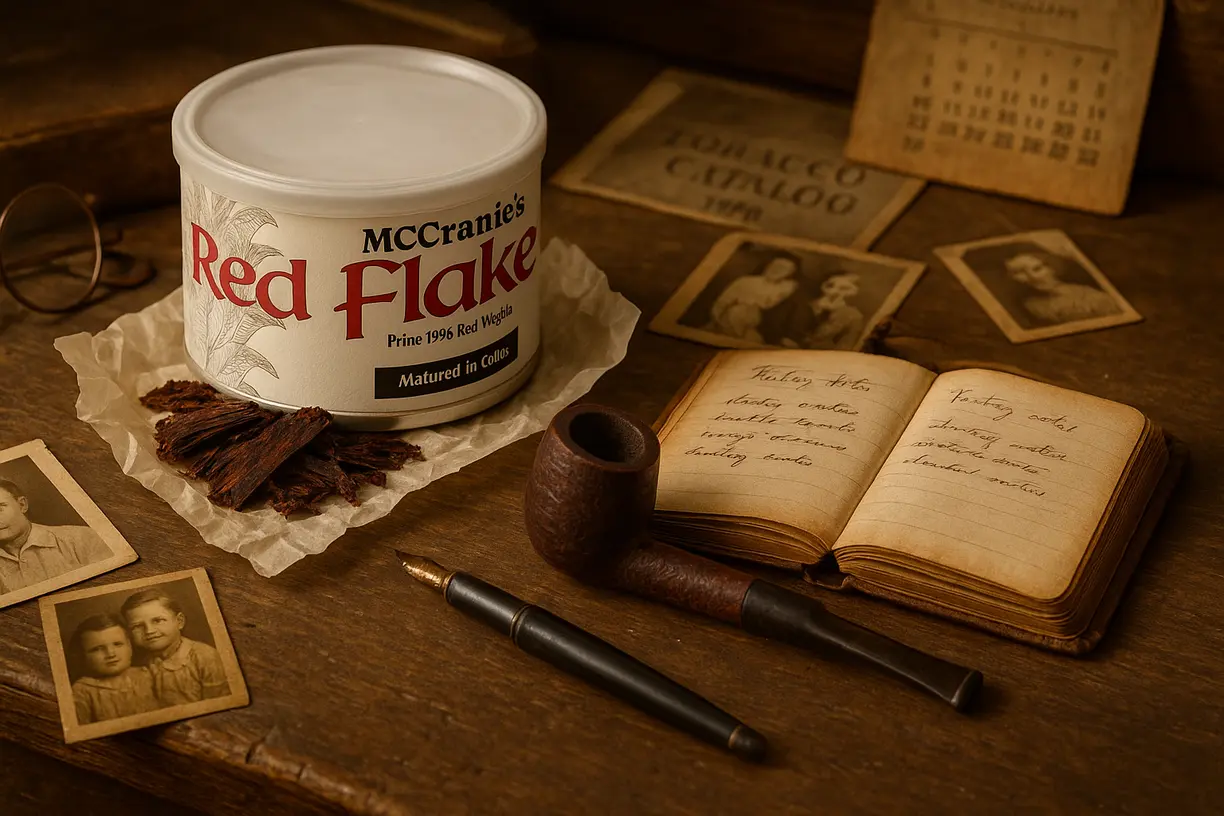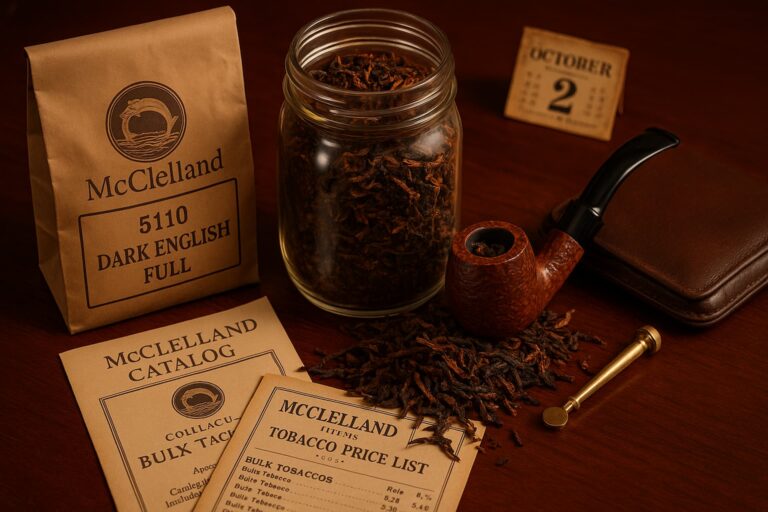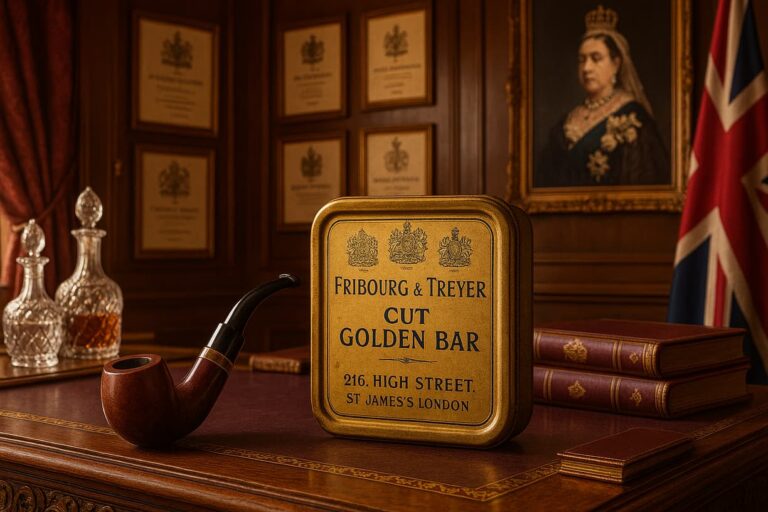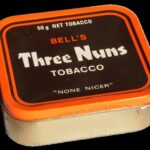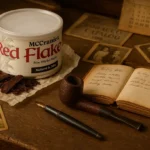“Some tobacco carries more than flavor—it carries memory, love, and the accumulated wisdom of generations. This McCranie’s Red Flake 1983, inherited from my father’s cellar along with his handwritten tasting notes, represents more than four decades of patient aging. It represents the continuation of a tradition, the passing of knowledge from father to son, and the profound connection that tobacco can create across time and generations.”
The Inheritance
The tin sits before me, its aged label bearing the simple inscription “McCranie’s Red Flake – 1983 Crop” in my father’s careful handwriting. Beside it lies a small notebook, its pages yellowed with age, containing his meticulous tasting notes from over the years. This isn’t just tobacco—it’s a legacy, a connection to a man who understood that some things are worth preserving not for their monetary value, but for the stories they tell and the memories they preserve.
When I inherited my father’s cellar eight years ago, I discovered the depth of his passion and the breadth of his knowledge in ways that our conversations had only hinted at. Among the carefully catalogued tins and jars, the McCranie’s Red Flake 1983 occupied a place of honor, wrapped in tissue paper and accompanied by a note that simply read: “For special occasions only. This is what Virginia tobacco can become when given time and respect. Save some for your son.” The weight of that instruction, the assumption that this tradition would continue, moves me even now as I prepare to open what may be the last tin of this extraordinary tobacco.
My father had acquired this tobacco in bulk from McCranie’s shop in Charlotte sometime in the mid-1980s, recognizing even then that the 1983 North Carolina crop represented something special. His notes from that period reveal his excitement: “Tom McCranie says this is from the same leaf McClelland uses for their 5100. If he’s right, this could be exceptional with age.” His instincts, as always, proved correct. What began as excellent tobacco has transformed over four decades into something approaching transcendence.
The emotional weight of smoking this tobacco extends beyond its rarity or quality. Each bowl represents a conversation with my father that we never had, a sharing of experience across the boundary of death. His notes become his voice, guiding me through the complexities of tobacco that has aged longer than many pipe smokers have been alive. In every puff, I taste not just the transformation of Virginia leaf, but the continuation of a tradition that connects us across time.
Forty-One Years of Transformation
Opening the tin reveals tobacco that bears little resemblance to what my father first cellared in the 1980s. The flakes have darkened to a deep mahogany, almost burgundy in places, with an oily sheen that speaks of the slow chemical processes that have been occurring over decades. The transformation is so complete that someone unfamiliar with aged Virginia might not recognize this as the same tobacco that once displayed the bright golden color typical of fresh red Virginia leaf.
The tin note is immediately arresting—rich, complex, and utterly distinctive. My father’s notes from 1995 describe it as “fruity and bright with hay-like sweetness.” By 2010, his observations had evolved: “developing fig and dark fruit character, losing the grassy notes.” Today, the aroma is dominated by deep, stewed fruit—figs, dates, and dark cherries—with underlying notes of leather, earth, and a subtle sweetness that suggests caramelized sugar. This is the aroma of tobacco that has undergone complete fermentation, where the natural sugars have transformed into complex compounds that create entirely new flavor profiles.
The flakes themselves have maintained their structure remarkably well, testament to the quality of the original pressing and the careful storage conditions my father maintained. They separate cleanly along their natural lines, revealing the beautiful marbling that occurs when different grades of Virginia leaf are pressed together and allowed to age. The moisture content is perfect—neither too dry nor too moist—allowing the tobacco to rub out easily while maintaining the integrity necessary for even burning.
What strikes me most about this aged tobacco is how completely it has integrated. In younger Virginia flakes, you can often detect the individual contributions of different leaf grades—the brightness here, the earthiness there, the sweetness in another place. In this forty-one-year specimen, such distinctions have largely disappeared, replaced by a unified character that incorporates all these elements into something greater than the sum of its parts. This is what proper aging can accomplish when applied to exceptional tobacco—not just the mellowing of harsh edges, but the creation of entirely new flavor compounds through the patient application of time.
A Father’s Guidance Through Time
As I prepare this tobacco for smoking, I find myself following my father’s detailed instructions, preserved in his notebook like a recipe passed down through generations. “Rub out gently,” he wrote, “the aged flakes are delicate but reward careful handling.” His advice proves sound—the tobacco separates beautifully, creating a mixture of ribbon and small chunks that pack easily in the bowl while maintaining the structure necessary for proper combustion.
I’ve chosen to smoke this remarkable tobacco in a Dunhill Shell Briar Group 4 billiard, a pipe that belonged to my father and carries its own emotional weight. The choice feels appropriate—tobacco that represents the pinnacle of American Virginia craftsmanship smoked in a pipe that represents the pinnacle of English pipe making, both connected by the man who appreciated quality regardless of its origin. The pipe’s seasoned briar and generous bowl provide the perfect platform for experiencing the full character of this aged tobacco.
My father’s smoking notes from various years provide a roadmap through the tobacco’s evolution. In 1987: “Bright, tangy, with good Virginia character but still young.” By 1995: “Developing complexity, the fruit notes are emerging.” In 2005: “Remarkable transformation, this is becoming something special.” His final entry, from 2015, just months before his death: “Thirty-two years old now. This is what patience can accomplish. Save the rest for the boy—he’ll understand someday.”
The initial charring light reveals the tobacco’s exceptional quality immediately. There’s no harshness, no bite, no aggressive edges that need to be tamed. Instead, the tobacco lights easily and burns evenly, producing thick, cool smoke that carries the full complexity of four decades of aging. The first impression is of incredible sweetness—not the simple sugar sweetness of young Virginia, but the complex, wine-like sweetness that develops through extended fermentation.
The Smoking Experience: A Conversation Across Time
As the bowl settles into its rhythm, the true genius of this aged tobacco becomes apparent. The flavor profile is extraordinarily complex, with layers that reveal themselves gradually as the tobacco burns. The dominant notes are of dark fruit—figs, dates, and stewed cherries—but these are supported by subtle undertones of leather, earth, and a mineral quality that speaks of the North Carolina soil where this tobacco was grown over forty years ago.
What makes this smoking experience truly exceptional is how the flavors evolve throughout the bowl. The first third emphasizes the fruit character, with the fig and date notes most prominent. My father’s notes describe this phase as “like smoking a fine wine,” and the comparison is apt. There’s a richness and depth to the flavor that suggests the same kind of complexity that develops in aged spirits or vintage wines.
The middle third reveals the tobacco’s Virginia heritage most clearly, with the characteristic tangy sweetness that defines quality red Virginia leaf. But this isn’t the bright, sometimes sharp tanginess of young Virginia—it’s mellowed and refined, integrated with the other flavor components to create a harmonious whole. The sweetness is profound but never cloying, balanced by earthy undertones that provide complexity and depth.
The final third brings out the tobacco’s most subtle qualities—hints of vanilla and caramel that suggest the breakdown of natural sugars over decades of aging, along with a mineral earthiness that connects this tobacco to its agricultural origins. The finish is long and satisfying, with a pleasant aftertaste that lingers for minutes after the bowl is finished. This is tobacco that rewards contemplation, tobacco that invites you to slow down and appreciate the complexity that only time can create.
Throughout the smoking experience, I find myself consulting my father’s notes, comparing my impressions to his observations from different periods in the tobacco’s aging process. The continuity is remarkable—the same basic character that he identified in the 1980s is still present, but refined and deepened by decades of patient transformation. It’s like reading a conversation between past and present, with the tobacco serving as the medium through which his knowledge and experience continue to guide and inform.
The McClelland Connection
Understanding this tobacco’s exceptional quality requires understanding its connection to McClelland Tobacco Company. My father’s research, meticulously documented in his notes, revealed that McCranie’s Red Flake was essentially McClelland’s bulk 5100 red Virginia, selected from specific crop years and tinned under the McCranie’s label. This connection explains both the tobacco’s exceptional aging potential and its remarkable character development over four decades.
McClelland’s approach to Virginia processing was legendary in the tobacco world, involving careful selection of leaf, precise fermentation, and patient aging that created tobacco with exceptional potential for further development. The 1983 crop that forms the basis of this tobacco was processed during McClelland’s prime years, when the company had access to the finest North Carolina leaf and the expertise to transform it into something extraordinary.
My father understood this connection and its implications for aging. His notes from the 1980s reveal his excitement at discovering tobacco with McClelland’s processing applied to exceptional leaf: “If this ages like McClelland’s other Virginias, it could become something truly special.” His prediction proved remarkably prescient—this tobacco has developed the same kind of complex, wine-like character that made McClelland’s aged Virginias legendary among connoisseurs.
The McClelland connection also explains the tobacco’s remarkable consistency and quality. This isn’t tobacco that was blended to a price point or processed for immediate consumption. It’s tobacco that was crafted with the understanding that its true potential would only be realized through extended aging, tobacco that was made for patients collectors who understood that some things improve with time.
The Weight of Legacy
As I smoke this remarkable tobacco, I’m acutely aware that I’m participating in something larger than a simple smoking experience. This tobacco represents the culmination of my father’s passion for pipe smoking, his understanding of tobacco quality, and his faith in the future. His decision to cellar this tobacco for decades, to preserve it through changing times and personal circumstances, represents a kind of optimism—a belief that there would be someone to appreciate and understand what he had preserved.
The emotional weight of this experience extends beyond nostalgia or sentimentality. This tobacco represents a form of communication across time, a way for my father to share his knowledge and passion even after death. His notes don’t just describe flavor profiles and aging characteristics—they reveal his thought processes, his growing understanding of tobacco’s potential, and his excitement at witnessing transformation over decades.
There’s also a profound responsibility in smoking this tobacco. Each bowl reduces the finite supply, bringing me closer to the end of this particular connection to my father’s legacy. The knowledge that this may be among the last opportunities to experience tobacco of this age and quality adds poignancy to every puff. It’s tobacco that demands attention, respect, and appreciation—not just for its exceptional character, but for what it represents.
The decision to review this tobacco, to share this experience with others, reflects my father’s own generosity in sharing knowledge and passion. He never hoarded his best tobacco or kept his discoveries to himself. Instead, he delighted in introducing others to exceptional tobacco, in sharing the excitement of discovery and the pleasure of quality. This review represents a continuation of that tradition, a way of honoring his memory while sharing the knowledge he passed down.
The Lesson of Patience
Perhaps the most profound lesson this tobacco teaches is the value of patience. In our modern world of instant gratification and immediate consumption, the idea of setting aside tobacco for decades seems almost quaint. Yet this McCranie’s Red Flake 1983 demonstrates what can be accomplished when we resist the urge for immediate pleasure and instead invest in the future.
My father’s decision to cellar this tobacco required faith—faith that it would improve with age, faith that there would be someone to appreciate it, faith that the investment of time and storage space would be rewarded. That faith has been vindicated in the most spectacular way possible. What began as excellent tobacco has become something transcendent, something that could not be purchased at any price because it simply cannot be replicated.
The transformation this tobacco has undergone also demonstrates the living nature of tobacco. This isn’t a static product that remains unchanged over time—it’s a dynamic substance that continues to evolve and develop under proper conditions. The tobacco I’m smoking today is fundamentally different from what my father first cellared, yet it retains the essential character that made it worth preserving in the first place.
This lesson extends beyond tobacco to life itself. The things worth having often require patience, investment, and faith in the future. The immediate gratification of smoking this tobacco when it was young would have provided pleasure, but it would have prevented the profound experience that four decades of aging has created. Sometimes the greatest rewards come to those who are willing to wait, to invest in possibilities rather than certainties.
The Final Bowl
As I reach the end of this bowl, savoring the sweet, complex flavors that emerge as the tobacco burns down to ash, I’m struck by the profound connection this experience has created. Through this tobacco, I’ve shared an experience with my father that transcends death, participated in a tradition that connects generations of pipe smokers, and witnessed the transformation that time can work on exceptional tobacco.
This McCranie’s Red Flake 1983 represents more than just aged tobacco—it represents the culmination of American Virginia processing at its finest, the patience and vision of a collector who understood that some things improve with time, and the continuation of traditions that connect us to the past while pointing toward the future. It’s tobacco that tells a story, carries memory, and creates connections across time and generations.
The knowledge that only a small amount of this tobacco remains adds urgency to the experience. Each bowl is precious, irreplaceable, and finite. Yet this scarcity also adds meaning—it reminds us that the finest things in life are often the rarest, that quality and time create value that cannot be measured in monetary terms, and that some experiences are worth preserving and savoring rather than consuming carelessly.
As I clean my father’s pipe and carefully store the remaining tobacco, I’m already planning when I might smoke it again. Special occasions, moments of reflection, times when I want to feel connected to the man who taught me to appreciate quality and understand patience. This tobacco has become more than a smoking experience—it’s become a ritual, a way of honoring memory while creating new experiences that will, in turn, become memories.
In the end, this McCranie’s Red Flake 1983 represents everything that makes pipe smoking meaningful—the connection to tradition, the appreciation of quality, the understanding that some pleasures improve with patience, and the recognition that tobacco can carry more than flavor. It can carry love, memory, and the accumulated wisdom of generations. In every bowl lies not just the story of exceptional tobacco, but the story of the man who preserved it and the son who inherited not just tobacco, but a legacy of appreciation for the finest things in life.
Rating: ★★★★★ (5/5 stars)
Availability: Discontinued
Original Manufacturer: McCranie’s Pipe & Tobacco Shop, Charlotte, NC
Tobacco Source: McClelland 5100 red Virginia (1983 crop)
Blend Type: Pure Red Virginia Flake
Strength: Medium
Character: Complex, sweet, fruity, with deep earth and leather notes
Aging: 41+ years (1983-2024)
Cut: Flake
Heritage: North Carolina red Virginia processed by McClelland, representing the pinnacle of American Virginia craftsmanship
Some tobacco transcends its physical form to become something larger—a connection to the past, a bridge between generations, a repository of memory and love. This McCranie’s Red Flake 1983, inherited from my father’s cellar along with his careful notes and accumulated wisdom, represents more than four decades of patient aging and the continuation of a tradition that values quality, patience, and the understanding that some things are worth preserving not for their monetary value, but for the stories they tell and the connections they create. In every bowl lies not just exceptional tobacco, but a father’s legacy and a son’s gratitude for lessons that extend far beyond the realm of pipe smoking into the deeper truths about patience, quality, and the things that truly matter in life.
